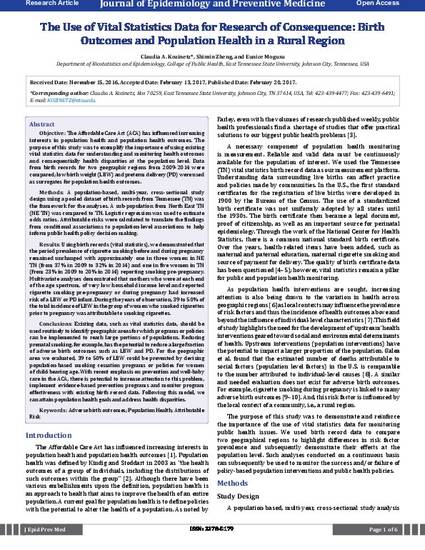
Objective: The Affordable Care Act (ACA) has influenced increasing interests in population health and population health outcomes. The purpose of this study was to exemplify the importance of using existing vital statistics data for understanding and monitoring health outcomes and consequentially health disparities at the population level. Data from birth records for two geographic regions from 2009-2014 were compared; low birth weight (LBW) and preterm delivery (PD) were used as surrogates for population health outcomes.
Methods: A population-based, multi-year, cross-sectional study design using a pooled dataset of birth records from Tennessee (TN) was the framework for the analyses. A sub-population from North East TN (NE TN) was compared to TN. Logistic regression was used to estimate odds ratios. Attributable risks were calculated to translate the findings from conditional associations to population-level associations to help inform public health policy decision-making.
Results: Using birth records (vital statistics), we demonstrated that the period prevalence of cigarette smoking before and during pregnancy remained unchanged with approximately one in three women in NE TN (from 37% in 2009 to 32% in 2014) and one in five women in TN (from 23% in 2009 to 20% in 2014) reporting smoking pre-pregnancy. Multivariate analyses demonstrated that mothers who were at each end of the age spectrum, of very low household income level and reported cigarette smoking pre-pregnancy or during pregnancy had increased risk of a LBW or PD infant. During the years of observation, 39 to 50% of the total incidence of LBW in the group of women who smoked cigarettes prior to pregnancy was attributable to smoking cigarettes.
Conclusions: Existing data, such as vital statistics data, should be used routinely to identify geographic areas for which programs or policies can be implemented to reach large portions of populations. Reducing prenatal smoking, for example, has the potential to reduce a large fraction of adverse birth outcomes such as LBW and PD. For the geographic area we evaluated, 39 to 50% of LBW could be prevented by devising population-based smoking cessation programs or policies for women of child-bearing age. With recent emphasis on prevention and well-baby care in the ACA, there is potential to increase attention to this problem, implement evidence-based prevention programs and monitor program effectiveness with existing birth record data. Following this model, we can attain population health goals and address health disparities.
Available at: http://works.bepress.com/shimin-zheng/72/

© 2017 Kozinetz CA, et al. This document was originally published in Journal of Epidemiology and Preventive Medicine.